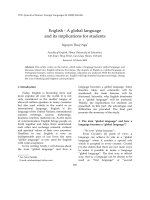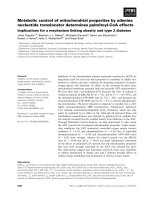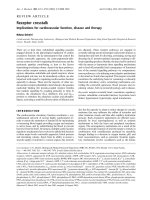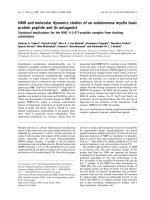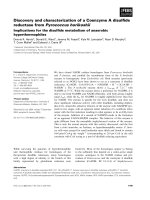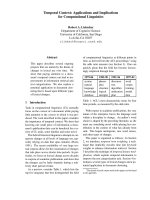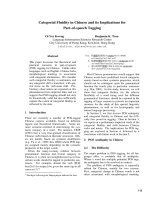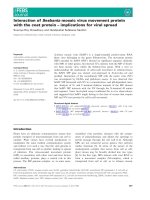Shame and guilt-proneness Divergent implications for problematic alcohol use and drinking to cope with anxiety and depression symptomatology
Bạn đang xem bản rút gọn của tài liệu. Xem và tải ngay bản đầy đủ của tài liệu tại đây (100.65 KB, 5 trang )
Personality and Individual Differences 53 (2012) 613–617
Contents lists available at SciVerse ScienceDirect
Personality and Individual Differences
journal homepage: www.elsevier.com/locate/paid
Shame and guilt-proneness: Divergent implications for problematic alcohol
use and drinking to cope with anxiety and depression symptomatology
Matt Treeby ⇑, Raimondo Bruno
School of Psychology, University of Tasmania, Sandy Bay, Australia
a r t i c l e
i n f o
Article history:
Received 7 February 2012
Received in revised form 5 May 2012
Accepted 10 May 2012
Available online 3 June 2012
Keywords:
Shame
Guilt
Alcohol
Coping
Depression
Anxiety
a b s t r a c t
Shame and guilt are closely related emotions of negative affect that give rise to considerably divergent
motivational and self-regulatory behaviors. While shame-proneness has demonstrated replicable relationships with increased alcohol use disorder symptomatology, guilt-proneness appears to protect an
individual against development of problematic alcohol use. One prominent but untested hypothesis is
that shame-prone individuals are motivated to consume alcohol in order to down-regulate experiences
of negative affect. The present study aimed to test this hypothesis by exploring relationships between
shame and guilt-proneness with motivations for consuming alcohol. University students (N = 281) completed measures of shame and guilt-proneness, measures of alcohol use disorder symptomatology, and a
measure assessing five motivational domains for consuming alcohol. Shame-proneness was positively
associated with problematic alcohol use and drinking as a means of coping with anxiety and depression-related symptomatology. In contrast, guilt-proneness was inversely related to alcohol problems
and drinking to cope with depression. This study provides initial support for the hypothesis that
shame-prone individuals are inclined to consume alcohol in order to cope with negative affect states.
These findings may help explain the inverse relationship between guilt-proneness and alcohol problems
and the apparent positive relationship between shame-proneness and problematic alcohol use.
Crown Copyright Ó 2012 Published by Elsevier Ltd. All rights reserved.
1. Introduction
Shame and guilt are similar yet distinct self-conscious emotions
of negative affect that lead to notably different motivational and
self-regulatory outcomes (Tangney & Dearing, 2002). The two emotions are alike in that they both involve internal attributions for
negative events and also have similar antecedents, typically a negative event involving the production of a transgressive behavior
that breaches an internalized moral principle (Tangney, 1992).
However, a key distinction between shame and guilt lies in the
perceived role of the self in each emotion (Lewis, 1971; Tangney,
Stuewig, & Mashek, 2007). With highly aversive experiences of
shame, the individual focuses squarely on the self (e.g., ‘‘How could
I have done that?’’) with reprehensible behavior seen as evidence
that the self is flawed (e.g., ‘‘I am a bad person’’). On the other hand,
the individual experiencing the unpleasant but less aversive feelings of guilt is focused not on the self, but on their problematic
behavior (e.g., ‘‘How could I have done that?’’) and ways in which
they may remedy the situation (e.g., ‘‘I have to fix this’’).
While guilt has been found to be positively associated with a
host of adaptive functioning variables including successful
emotion-regulation, enhanced empathy, and healthy interpersonal
⇑ Corresponding author. Tel.: +61 3 6230 7901; fax: +61 3 6230 7922.
E-mail address: (M. Treeby).
functioning, shame is associated with a gamut of difficulties
including psychopathology, poor anger regulation, and interpersonal problems (see Tangney & Dearing, 2002, for a review).
Several researchers have also determined that the two emotions
have divergent implications for substance use-related problems
(e.g., Dearing, Stuewig, & Tangney, 2005; Meehan et al., 1996;
O’Connor, Berry, Inaba, Weiss, & Morrison, 1994), with findings
indicating that shame-proneness is positively associated with
problematic substance use, while guilt-proneness appears to buffer
individuals against developing substance use-related difficulties.
Studies by Meehan et al. (1996) and O’Connor et al. (1994) both
found that treatment-seeking substance dependent individuals
were higher in shame-proneness and lower in guilt-proneness
than community drawn individuals without substance use issues.
Similarly, Dearing et al. (2005) found that guilt-proneness was
inversely related to problematic alcohol use in two samples of
undergraduate students, while shame-proneness was found to be
positively related with alcohol use disorder symptomatology.
In discussing the apparent link between shame-proneness and
alcohol problems, several theorists (e.g., Dearing et al., 2005;
Fossum & Mason, 1986; Potter-Efron, 2002; Stuewig & Tangney,
2007; Tangney & Dearing, 2002; Wiechelt, 2007) have hypothesised that shame-prone individuals drink as a means of downregulating or coping with frequent and highly aversive experiences
of shame and other negative emotions. This hypothesis is consistent
0191-8869/$ - see front matter Crown Copyright Ó 2012 Published by Elsevier Ltd. All rights reserved.
/>
614
M. Treeby, R. Bruno / Personality and Individual Differences 53 (2012) 613–617
with research indicating that drinking to down-regulate negative
affect (e.g., anxiety and depression) is a commonly reported motivation or reason for consuming alcohol (Grant, Stewart, O’Connor,
Blackwell, & Conrod, 2007). Generally considered to be problematic and maladaptive, drinking to down-regulate negative affect
provides negative-reinforcement for continued alcohol use and appears to place individuals at greater risk of alcohol dependence
(Carpenter & Hasin, 1999). Moreover, drinking to cope with negative affect is positively associated with drinking in greater quantities and an increased likelihood of experiencing negative alcohol
use-related consequences (Grant, Stewart, O’Connor, Blackwell, &
Conrod, 2007).
While a relationship between shame-proneness and drinking as
a means of down-regulating negative affect has been proposed by
several theorists (e.g., Dearing et al., 2005; Potter-Efron, 2002;
Stuewig & Tangney, 2007; Wiechelt, 2007), there does not appear
to be any evidence to suggest that this is also true for guilt-proneness. Firstly, guilt-proneness tends to be unrelated or inversely
related to proneness to negative affect and psychopathology in
general (Tangney & Dearing, 2002). Moreover, guilt is associated
with a host of adaptive functioning variables and self-regulatory
behaviors, including the successful regulation of alcohol use
(Dearing et al., 2005). Taken together, it appears reasonable to suggest that guilt-proneness is unrelated to the motivation to drink as
a means of coping with negative affect. Nevertheless, with research
indicating that guilt-proneness is inversely related to the experience of alcohol disorder symptomatology, the reasons that guiltprone individuals report for consuming alcohol certainly warrants
exploratory investigation.
The current paper aims to replicate the seemingly divergent
relationships between shame and guilt-proneness with problematic alcohol use and extend the existing literature by exploring
the unique correlates of shame and guilt-proneness with self-reported reasons for drinking. Drawing on a hypothesis prominent
in the shame and alcohol use literature (e.g., Potter-Efron, 2002;
Stuewig & Tangney, 2007; Tangney & Dearing, 2002; Wiechelt,
2007), it was expected that shame-proneness would be associated
with self-reports of drinking in order to down-regulate depression
and anxiety symptomatology. Guilt-proneness, on the other hand,
was expected to be unrelated to the use of alcohol in order to cope
with these negative affect states.
2. Methods
2.1. Participants
Participants were 281 students, drawn from a variety of degree
programs at the University of Tasmania, Australia. The ages of participants ranged from 17 to 62 with a mean age of 22.2 (SD = 7.8).
The mean age for the 74 male participants was 21.94 (SD = 6.97),
while the mean age of the 207 female participants was 22.32
(SD = 8.12). With regard to ethnicity, the sample was predominately White (90%), 4% were Asian, 1% were Black, 1% was Hispanic,
and 4% were of other or mixed ethnicity.
2.2. Materials
2.2.1. Test of Self-Conscious Affect-3: short version
The Test of Self-Conscious Affect-3 (TOSCA-3: Tangney, Dearing,
Wagner, & Gramzow, 2000) is a scenario-based measure that yields
indices of Shame-proneness, Guilt-proneness, Externalization, and
Detachment/Unconcern. Respondents are presented with a series
of 11 negative scenarios they may encounter in daily life. A sample
scenario from the TOSCA-3 is ‘‘At work, you wait until the last minute to plan a project, and it turns out badly’’. The response options
that follow this scenario are ‘‘You would feel incompetent’’ (shame
response), You would feel: ‘‘I deserve to be reprimanded for mismanaging the project’’ (guilt response), You would think: ‘‘There are never
enough hours in the day’’ (externalization), and You would think:
‘‘What’s done is done’’ (detached).
Respondents are required to rate their likelihood of each response on a five-point scale with end-point designations of not
likely (1) and very likely (5). In the present study, Cronbach alphas
were .69 for Shame-proneness, .68 for Guilt-proneness, .66 for
Detachment/Unconcern, and .73 for Externalization. For the purposes of the present study, only the shame and guilt-proneness
subscales of the TOSCA-3 were used.
2.2.2. Alcohol Use Disorder Identification Disorder Test
The Alcohol Use Disorders Identification Test (AUDIT: Saunders,
Aasland, Babor, de la Fuente, & Grant, 1993) was used to assess
alcohol use disorder symptomatology. Developed by the World
Health Organization, the AUDIT is 10-item screening assessment
used to identify hazardous and harmful alcohol consumption.
The measure assesses three conceptual domains: frequency and
quantity of alcohol intake (3 items), dependence indicators (3
items), and adverse alcohol use-related consequences (4 items).
An example item from the AUDIT is ‘‘How often do you have six or
more standard drinks on one occasion?’’ with response options of
Never, less than monthly, monthly, weekly, and daily or almost daily.
Responses to each question are scored from 0 to 4, giving a maximum possible score of 40. Higher scores on the AUDIT are indicative of progressively more hazardous drinking and an increasing
likelihood of dependence.
The AUDIT is widely used and its psychometric properties have
been found to be strong (Reinert & Allen, 2007). The AUDIT demonstrated good internal consistency in the present sample with
Cronbach alpha = .80.
2.2.3. Young Adult Alcohol Consequences Questionnaire
Negative alcohol use-related consequences were measured
using the Young Adult Alcohol Consequences Questionnaire (YAACQ;
Read, Kahler, Strong, & Colder, 2006). The YAACQ is a 48-item measure that assesses alcohol use-related consequences of varying
severity across eight problem domains: Social consequences,
impaired control, negative self-perception, self-care neglect, risky
behaviors, academic/occupational consequences, physical dependence indicators, and blackout drinking. Example items from the
YAACQ are ‘‘I have had a hangover (headache, sick stomach) the
morning after I had been drinking’’ and ‘‘My drinking has created
problems between myself and my boyfriend/girlfriend/spouse, parents,
or other near relatives’’. Individuals are required to indicate whether
they have experienced each alcohol use problem in the past year
using a dichotomous (Yes/No) rating system. Responses marked
‘‘Yes’’ are given a score of one while responses marked ‘‘No’’ receive
zero. The maximum score on the YAACQ is 48, with higher scores
indicating that the individual has experienced a greater number
of negative alcohol use-related consequences. In the present study,
Cronbach alpha for YAACQ was .91.
Kahler, Strong, and Read (2005) used Rasch modeling of the
YAACQ to create a unidimensional Alcohol Problem Severity Index
which is acquired by summing 24 of the YAACQ’s items. Kahler
et al. (2005) report that the 24-item Alcohol Problem Severity Index has good internal consistency (Cronbach alpha = .83). In the
present study, Cronbach alpha for the Alcohol Problem Severity
Index was .90.
2.2.4. Modified Drinking Motives Questionnaire – Revised
The Modified Drinking Motives Questionnaire – Revised (MDMQR: Grant, Stewart, O’Connor, Blackwell, & Conrod, 2007) was used
to assess individual differences in self-reported motives for
615
M. Treeby, R. Bruno / Personality and Individual Differences 53 (2012) 613–617
consuming alcohol. The 28 item MDMQ-R measures five drinking
motive domains, yielding five subscales: Social (5 items), Conformity (5 items), Enhancement (5 items), Coping-Depression (9
items), and Coping-Anxiety (4 items). Participants are asked to take
into consideration all the times they consume alcohol and indicate
how often they drink for the reason stated using a 5-point Likert
scale ranging from 1 (Almost Never or Never) to 5 (Almost Always
or Always). Example items from the Social, Conformity, and
Enhancement subscales are ‘‘To be sociable’’, ‘‘To be liked’’, and ‘‘Because I like the feeling’’, respectively. An example item from the
Coping-Depression scale is ‘‘Because it helps me when I am feeling
depressed’’, while an example item from the Coping-Anxiety scale
is ‘‘To reduce my anxiety’’. In the present study, Cronbach alphas
ranged between .72 for the Coping-Anxiety subscale and .92 for
the Coping-Depression subscale.
In light of the substantial and frequently observed correlations
between measures of shame and guilt, Tangney and Dearing
(2002) recommend partialing out shared variance between shame
and guilt to isolate ‘‘shame-free guilt’’ and ‘‘guilt-free shame’’ when
examining relationships between shame, guilt, and other constructs. As compared to raw scores, Tangney and colleagues have
repeatedly demonstrated that shame and guilt residuals each have
functionally distinct and unique variance that will often serve as
more substantial predictors of target variables. Therefore, to provide a more refined analysis, part-correlation analysis was used
when exploring relationships between shame and guilt with problematic alcohol use and the motivations for drinking assessed in
the present study. This part-correlation analysis strategy was
adopted for all analyses.
3.2. Relationships between shame and guilt with alcohol use disorder
symptomatology, negative alcohol use related consequences, and
drinking motives
2.3. Procedure
Data for the present study were collected as part of a larger
investigation of the implications of shame and guilt for the regulation of alcohol use. Approval to conduct the present study was
obtained from The Tasmanian Social Sciences Human Research
Ethics Committee. Participants were recruited through advertisements placed on notice boards around the University of Tasmania,
and those who were undergraduate psychology students received
course credit for their participation. Participants were informed
that the study was investigating relationships between personality,
emotions, alcohol use, and behavior, and that individuals who reported that they consume alcohol at any quantity and frequency
were eligible for participation. Participants were provided with
anonymous questionnaire booklets and instructed to complete
them at a convenient time and return it to the investigator in a
provided sealed envelope.
3. Results
3.1. Analysis
Shame and guilt are both self-conscious emotions of negative
valence that involve internal attributions for transgressions
(Tangney et al., 2007). Due to these similarities and overlapping
phenomenology, measures of shame and guilt correlate quite substantially. Consistent in magnitude and direction with past research (Tangney & Dearing, 2002), the shame and guilt scales of
the TOSCA-3 correlated positively in the present study (r = .38,
p < .001, n = 281).
Descriptive statistics for the AUDIT, YAACQ, Alcohol Problem
Severity Index, TOSCA-3, and the MDMQ-R are presented in Table
1. Total scores of eight or more on the AUDIT are seen as an indicator of hazardous and harmful alcohol use, in addition to possible
alcohol dependence (Babor, Higgins-Biddle, Saunders, & Monteiro,
2001). Mean scores on the AUDIT were greater than eight
(M = 9.64, SD = 5.90), which indicates that the sample generally
comprised individuals drinking at relatively high levels.
Bivariate and part-correlations between shame and guilt with
the AUDIT, YAACQ, and the Alcohol Problem Severity Index are
presented in Table 2. Examining the bivariate correlations, shame
was positively related to YAACQ and the Alcohol Problem Severity
Index. Guilt was unrelated to the AUDIT, YAACQ, and Alcohol Problem Severity Index. However, in keeping with the aforementioned
rationale, it is more informative to examine relationships between
shame and guilt with other constructs of interest in terms of semipartial (i.e., residualized) correlations, partitioning guilt out of
shame producing shame-free guilt and vice versa. With this done,
small-magnitude positive relationships were found between guiltfree shame and total scores on the AUDIT, YAACQ, and the Alcohol
Problem Severity Index. In contrast, small-magnitude inverse relationships were found between shame-free guilt and total AUDIT,
YAACQ, and the Alcohol Problem Severity Index.
Bivariate and part-correlations between shame and guilt with
drinking motives are presented in Table 3. Examining the more
informative part-correlations, medium-magnitude positive relationships were found between guilt-free shame and drinking as a
Table 1
Descriptive statistics for the Alcohol Use Disorders Identification Test, Young Adult Alcohol Consequences Questionnaire, Alcohol Problem Severity Index, test of self conscious
affect-3 and Modified Drinking Motives Questionnaire-Revised.
Measure
# of items
Possible range
n
Mean
SD
Observed range
AUDIT
YAACQ
Alcohol prob severity index
12
48
28
0–40
0–48
0–28
281
281
281
9.64
13.64
7.72
5.90
9.99
5.41
1–32
0–41
0–21
TOSCA-3
Shame-proneness
Guilt-proneness
11
11
11–55
11–55
281
281
33.99
45.59
6.37
4.96
13–54
22–55
5–25
4–20
9–45
5–25
5–25
281
281
280
281
281
15.83
8.24
13.21
13.51
7.97
3.97
3.29
6.16
4.92
3.43
7–25
4–20
9–45
5–25
5–21
MDMQ-R
Social
Coping-Anxiety
Coping-Depression
Enhancement
Conformity
5
4
9
5
5
Note: N = 280–281. Increasing scores on the AUDIT indicate a greater likelihood of disordered alcohol use. Increasing scores on the YAACQ and Alcohol Problem Severity Index
indicate the greater experience of negative alcohol use-related consequences. Increasing scores on the TOSCA-3 subscales indicate greater levels of shame or guilt-proneness.
Increasing scores on the MDMQ-R indicate greater endorsement and more frequent motivation to consume alcohol for each respective motivation domain.
616
M. Treeby, R. Bruno / Personality and Individual Differences 53 (2012) 613–617
Table 2
Relationships between shame and guilt-proneness with the Alcohol Use Disorders
Identification Test (AUDIT), the Young Adult Alcohol Consequences Questionnaire
(YAACQ), and the Alcohol Problem Severity Index.
Measure
Total AUDIT
Total YAACQ
Alcohol prob severity index
Bivariate correlations
Part correlations
Shame
Guilt
Shame
Guilt
.08
.14*
.14*
À.11
À.12
À.10
.13*
.20**
.19**
À.15*
À.18**
À.17**
Note: N = 281. With the part correlations, shame is factored out from guilt and vice
versa to produce residualized ‘‘guilt-free shame’’ and ‘‘shame-free guilt’’.
*
p < .05.
**
p < .01.
Table 3
Relationships between shame and guilt-proneness with the MDMQ-R.
Measure
MDMQ-R
Social
Coping-anxiety
Coping-depression
Enhancement
Conformity
Bivariate correlations
Part correlations
Shame
Guilt
Shame
Guilt
.07
.29**
.27**
.10
.27**
.02
.03
À.02
À.13*
.04
.07
.30**
.30**
.16*
.27**
À.01
À.09
À.13*
À.18**
À.07
Note: N = 280–281. With the part correlations, shame is factored out from guilt and
vice versa to produce residualized ‘‘guilt-free shame’’ and ‘‘shame-free guilt’’.
*
p < .05.
**
p < .01.
means to cope with anxiety and depression. Moreover, a mediummagnitude positive relationship was found between guilt-free
shame and the motivation to drink due to conformity. Guilt-free
shame was also positively and significantly associated with drinking as means of enhancing mood, but this relationship was small in
magnitude. In contrast, a small-magnitude negative relationship
was found between shame-free guilt and drinking as a means to
cope with depression. Shame-free guilt was also negatively related
to drinking as a means of enhancing mood, although the magnitude of this relationship was small.
4. Discussion
The present study sought to replicate the divergent relationships between shame and guilt-proneness with problematic
alcohol use and extend the literature by identifying the reasons
for which shame and guilt-prone individuals consume alcohol.
Consistent with past research (Dearing et al., 2005), shame-proneness was found to be positively associated with alcohol use disorder symptomatology, while guilt-proneness was inversely
associated with problematic alcohol use. Findings from the present
study also provide empirical support for a component of the prominent, but previously untested, shame-alcohol use-shame spiral
hypothesis (see Dearing et al., 2005; Potter-Efron, 2002; Stuewig
& Tangney, 2007; Tangney & Dearing, 2002; Wiechelt, 2007), with
shame-proneness emerging as positively, albeit moderately, associated with drinking as a means of down-regulating anxiety and
depression symptomatology.
The finding that shame-prone individuals are indeed motivated
to drink to cope is notable as research indicates that using alcohol
to down-regulate negative affective states places individuals at a
greater risk of becoming alcohol dependent (Carpenter & Hasin,
1999). In an unexpected finding, shame-proneness was also positively associated with the tendency to drink for mood enhancement
purposes. Drinking to enhance mood can also be potentially problematic and lead to dependence in that it is associated with drinking
more frequently and at greater levels (see Grant, Stewart, O’Connor,
Blackwell, & Conrod, 2007).
Interestingly, a small-magnitude positive relationship was
found between shame-proneness and the motivation to consume
alcohol out of reasons of conformity. Cooper (1994) suggests that
conformity-related drinking operates according to negative-reinforcement principles in that it may help individuals avoid peer or
group-based rejection. Indeed, the finding that shame-prone individuals are inclined to drink due to conformity-related reasons is
consistent with research indicating that shame-proneness is positively associated with fear of negative evaluation from others
and a fear of the loss of social approval (Lutwak & Ferrari, 1997).
While it was hypothesised that guilt-proneness would be unrelated to drinking as a means of down-regulating negative emotions,
a small-magnitude negative correlation was found between guiltproneness and drinking to cope with depression symptomatology.
Consistent with a large body of research indicating that guilt is
associated with adaptive self-regulatory outcomes (Tangney
et al., 2007), this finding suggests that guilt-prone individuals are
less likely to rely on alcohol as a means of down-regulating and
coping with low mood than their less guilt-prone peers. In a finding that further indicates that guilt-prone individuals are disinclined to drink to manipulate mood states, a small-magnitude
negative relationship was found between guilt-proneness and
drinking for mood enhancement purposes. As guilt-proneness is
associated with successful affect regulation (Tangney & Dearing,
2002), it may be that guilt-prone individuals feel less of a need
or desire to consume alcohol in order to experience positive
emotion.
According to cognitive theories of addiction, relying on alcohol
as a mood adjuster can lead to the development of disordered alcohol use (see Beck, Wright, Newman, & Liese, 1993). As such, findings from the present study may help explain the link between
shame and alcohol use disorder symptomatology in that it appears
shame-prone individuals are inclined to use alcohol as an emotionregulation strategy. Conversely, guilt-prone individuals do not
appear to be inclined to use alcohol to manage their affective states
and it seems plausible that this may offer such individuals some
degree of protection against developing alcohol problems.
Findings from the present study have relevance for the prevention and treatment of problematic alcohol use, particularly for the
shame-prone individual seen in a clinical setting. If it becomes
apparent that a shame-prone individual is consuming alcohol in
order to down-regulate their negative affect states, intervention
focused on improving the individual’s ability to regulate their emotions through more adaptive means may be an avenue for the prevention or treatment of disordered alcohol use. Evidence-based
Cognitive Behavior Therapy (CBT) treatments for depression and
anxiety, which typically involve challenging dysfunctional thought
processes and behaviours, may be of some assistance in this
endeavour (see Beck et al., 1993). It seems plausible that should
shame-prone individuals become more adept at managing negative affect experiences using more adaptive approaches, they
may be less inclined to use alcohol consumption as a coping strategy. In turn, this may reduce the likelihood of the shame-prone
individual developing alcohol dependence over time.
While the present study focused on examining relationships
among dispositional shame and guilt-proneness and trait-like
motivations for consuming alcohol, further research is needed to
determine whether shame and guilt experienced in-the-moment
(i.e., state shame and guilt) relate to different drinking motives
and alcohol use patterns. Moreover, further research is needed to
examine whether shame and/or guilt-proneness are associated
with the tendency to experience alcohol use-related shame and
or guilt following transgressive alcohol consumption and the experience of associated negative alcohol use-related harms.
M. Treeby, R. Bruno / Personality and Individual Differences 53 (2012) 613–617
In summary, shame-proneness was positively associated with
problematic alcohol use and drinking as a means of down regulating
negative emotions. The latter finding is particularly notable as it appears to provide the first empirical support for a component of the
shame-alcohol use-shame spiral hypothesis (Dearing et al., 2005;
Potter-Efron, 2002; Stuewig & Tangney, 2007; Tangney & Dearing,
2002; Wiechelt, 2007), the notion that shame-prone individuals
are motivated to consume alcohol in order to down-regulate negative emotional states. In contrast to shame, guilt-proneness was inversely related to problematic alcohol use, drinking to cope with low
mood, and was either unrelated or inversely related to all other
motivations for drinking. Taken together, findings from the present
study provide additional support for Dearing et al.’s (2005) argument that it is important and necessary to clearly differentiate between shame and guilt-proneness when the constructs are
considered in substance use research and treatment contexts.
Findings from the present study also suggest that in clinical settings,
shame-prone individuals may benefit from learning how to manage
negative affect experiences adaptively and without potentially
dependence-establishing alcohol use.
Acknowledgement
This research was financially supported by an Australian Postgraduate Award (APA) scholarship awarded to the first author.
References
Babor, T. F., Higgins-Biddle, J. C., Saunders, J. B., & Monteiro, M. G. (2001). AUDIT –
The Alcohol Use Disorders Identification Test: Guidelines for use in primary health
care (2nd ed.). Geneva: World Health Organisation.
Beck, A. T., Wright, F. D., Newman, C. F., & Liese, B. S. (1993). Cognitive therapy of
substance abuse. New York: Guilford.
Carpenter, K. M., & Hasin, D. S. (1999). Drinking to cope with negative affect and
DSM-IV alcohol use disorders: A test of three alternative explanations. Journal of
Studies on Alcohol, 60, 694–704.
Cooper, M. L. (1994). Motivations for alcohol use among adolescents: Development
and validation of a four-factor model. Psychological Assessment, 6, 117–128.
617
Dearing, R. L., Stuewig, J., & Tangney, J. P. (2005). On the importance of
distinguishing shame from guilt: Relations to problematic alcohol and drug
use. Addictive Behaviors, 30, 1392–1404.
Fossum, M. A., & Mason, M. J. (1986). Facing shame: Families in recovery. New York:
W. W. Norton.
Grant, V. V., Stewart, S. H., O’Connor, R. M., Blackwell, E., & Conrod, P. J. (2007).
Psychometric evaluation of the five-factor Modified Drinking Motives
Questionnaire – Revised in undergraduates. Addictive Behaviors, 23, 2611–2632.
Kahler, C. W., Strong, D. R., & Read, J. P. (2005). Toward efficient and comprehensive
measurement of the alcohol problems continuum in college students: The Brief
Young Adult Alcohol Consequences Questionnaire. Alcoholism: Clinical and
Experimental Research, 29, 1180–1189.
Lewis, H. B. (1971). Shame and guilt in neurosis. New York: International Universities
Press.
Lutwak, N., & Ferrari, J. R. (1997). Shame-related social anxiety: Replicating a link
with various social interaction measures. Anxiety, Stress, and Coping, 10,
335–340.
Meehan, W., O’Connor, L. E., Berry, J. W., Weiss, J., Morrison, A., & Acampora, A.
(1996). Guilt, shame, and depression in clients in recovery from addiction.
Journal of Psychoactive Drugs, 28, 125–134.
O’Connor, L. E., Berry, J. W., Inaba, D., Weiss, J., & Morrison, A. (1994). Shame, guilt,
and depression in men and women in recovery from addiction. Journal of
Substance Abuse Treatment, 11, 503–510.
Potter-Efron, R. (2002). Shame, guilt, and alcoholism (2nd ed.). New York: Haworth
Press.
Read, J. P., Kahler, C. W., Strong, D. R., & Colder, C. R. (2006). Development and
preliminary validation of the Young Adult Alcohol Consequences Questionnaire.
Journal of Studies on Alcohol, 67, 169–177.
Reinert, D. F., & Allen, J. P. (2007). The Alcohol Use Disorders Identification Test: An
update of research findings. Alcoholism: Clinical and Experimental Research, 31,
185–199.
Saunders, J. B., Aasland, O. G., Babor, T. F., de la Fuente, J. R., & Grant, M. (1993).
Development of the Alcohol Use Disorders Identification Test (AUDIT): WHO
collaborative project on early detection of persons with harmful alcohol
consumption. Addiction, 88, 791–804.
Stuewig, J., & Tangney, J. P. (2007). Shame and guilt in antisocial and risky behaviors.
In J. L. Tracy, R. W. Robins, & J. P. Tangney (Eds.), The self-conscious emotions (pp.
371–388). New York: Guilford Press.
Tangney, J. P. (1992). Situational determinants of shame and guilt in young
adulthood. Personality and Social Psychology Bulletin, 18, 199–206.
Tangney, J. P., & Dearing, R. L. (2002). Shame and guilt. New York: Guilford.
Tangney, J. P., Dearing, R. L., Wagner, P. E., & Gramzow, R. (2000). The Test of SelfConscious Affect – 3 (TOSCA-3). Fairfax, VA: George Mason University.
Tangney, J. P., Stuewig, J., & Mashek, D. J. (2007). Moral emotions and moral
behavior. Annual Review of Psychology, 58, 345–372.
Wiechelt, S. A. (2007). The specter of shame in substance misuse. Substance Use and
Misuse, 42, 399–409.

